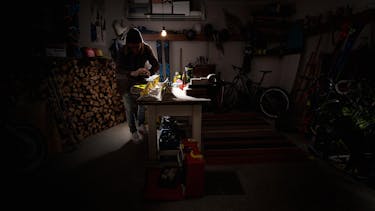The basics
If in need of rust removal, repair of deep gouges, or that level of work, you’re better off leaving it to the professionals. But waxing skis yourself is actually easy.
The frequency with which skis need wax is determined simply by the conditions on which they’re used and for how long. There really is no formula. The base of your skis should look and feel clear and smooth.
A waxed base that has seen some tough skiing will look murky or dull and will feel rough and uneven. When it looks and feels like it needs fresh wax, it probably does. For active skiers this could easily be several times in a winter.
An end-of-the-year waxing and cleaning prevents rust build-up over the summer and has you ready for an unexpected early snow the next year. Overall, waxing helps protect and extend the life of your skis.
New skis
New skis are typically pre-waxed and ready to go. Fischer skis certainly are! If you feel it will give you that something extra, then there is no harm in applying fresh wax and having the peace of mind that it was done the way you prefer.
Alpine vs. cross-country skis
The principle is the same for both types of skis. When the wax is heavily worn and losing effectiveness, new wax is needed.
Classic technique cross-country skis require two types of wax: one for grip during the kick phase, and one for reducing friction at the front and rear of the ski during the glide phase. Skate technique cross-country skis use only glide wax. The same is, logically, true for Alpine skis.
Waxing tools
Investing in the right tools and materials will pay off in the enjoyment of better performance and by making your skis last longer. Trying to improvise with equipment you have lying around the house is not a formula for success or happiness.
You’ll definitely need:
- Wax remover/cleaner
- Ski wax
- A nylon or copper brush
- A wax iron
- Plastic scraper
- A clean, soft cloth
Note that you could use a household iron, but we advise strongly against it. In an emergency, though, set it on “wool/silk” and be sure you can keep it at a steady temperature, typically between 120° - 140° C (248° - 284°F).
You’ll definitely want:
- Sandpaper and adhesive tape for effective cleaning of the base
- A carpet knife for removing small stones or tough leftover wax
- A workbench ski holder or a homemade version that is stable

The different waxes
There are any number of different ski waxes, with some being for highly specialized uses. In general, though, there are only two types:
- Hot wax, which comes in blocks of various shapes and sizes, and needs to be melted through contact with an iron to be applied to a ski. It penetrates more deeply, but is a more involved process.
- Cold wax is the description for liquid wax, which can be spread on the ski base directly from its container. It flows faster, but does not penetrate as deeply as hot wax.
Hot wax and cold wax are each offered in a high-fluorine and a low-fluorine version. High-fluorine wax allows smooth gliding in damp, heavy snow. Low-fluorine wax functions best in dry, powdery snow. Do not use common candle wax under any circumstances. Trust us.
No matter which wax you decide on, your skis need to be at a comfortable room temperature for any type of wax to go on properly and stay on. So, for about the cost of lunch at a ski resort, you can get the full supply of wax you’ll need for several waxing treatments. Learning to wax your skis is definitely good business!
Time to wax
We’ll describe the more complex technique of using hot wax. If you’re using cold (i.e. liquid) wax, disregard step 3.
- Step 1: Affix the ski securely so the base, or bottom, is facing upward.
- Step 2: Apply the wax remover and wipe clean as directed. Remove large bits of debris, stones, and remaining wax with the nylon or copper brush. If needed, lightly use sandpaper, then use the tape to pull off any remaining particles and dust. Only brush along the ski in one direction, from the front toward back.
- Step 3: Have the iron heating as you’re cleaning the ski base.
- Step 4: Press the wax block against the hot iron, let a thin bead of wax drip along the entire length of the ski. Or drip cold wax from its container.
- Step 5: Set aside the wax block. Then “iron” the wax into a into the ski base in a thin, even coat. Constantly move the iron, do not let the wax burn. Lightly use the scraper to spread cold wax.
- Step 6: Repeat steps 4 and 5 two more times, applying the wax slightly faster each time.
- Step 7: Let the wax set for an absolute minimum of one hour. Four hours is ideal.
If this is preparation for summer storage, coat the steel edges with wax, and leave it on in order to prevent rust buildup.
Removing excess wax
- Step 1: Scrape any wax off the steel edges of the ski.
- Step 2: Run the scraper back and forth along the length of the ski, applying pressure. Remove all wax from the ski base. The only wax that should remain will be in the fine channels of the surface of the base material itself.
- Step 3: Brush the surface with force to remove any remaining visible wax. Be sure nothing has stuck onto or become trapped in the wax. Wipe down with a clean cloth.
The base should now have a smooth, glassy surface to the touch and to the eye.
Go skiing
Your skis are ready. They will last longer and perform better. You have a brand new skill that will bring you more skiing enjoyment and save you a little money along the way. Now head to the mountains.



